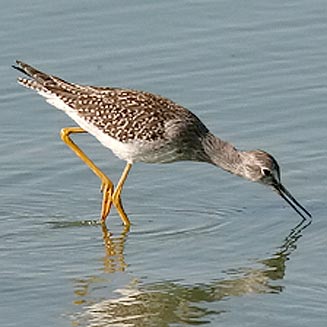|
Tringa melanoleuca (Greater
yellowlegs)
Grootgeelpootruiter [Afrikaans]; Grote geelpootruiter
[Dutch]; Grand chevalier [French]; Großer gelbschenkel [German];
Perna-amarela-grande [Portuguese]
Life
> Eukaryotes >
Opisthokonta
> Metazoa (animals) >
Bilateria >
Deuterostomia > Chordata >
Craniata > Vertebrata (vertebrates) > Gnathostomata (jawed
vertebrates) > Teleostomi (teleost fish) > Osteichthyes (bony fish) > Class:
Sarcopterygii (lobe-finned
fish) > Stegocephalia (terrestrial
vertebrates) > Tetrapoda
(four-legged vertebrates) > Reptiliomorpha > Amniota >
Reptilia (reptiles) >
Romeriida > Diapsida > Archosauromorpha > Archosauria >
Dinosauria
(dinosaurs) > Saurischia > Theropoda (bipedal predatory dinosaurs) >
Coelurosauria > Maniraptora > Aves
(birds) >
Order: Charadriiformes > Family: Scolopacidae
 |
|
|
Greater yellowlegs, California, USA. [photo
Jeff Poklen
©] |
|
Distribution and habitat
Breeds from southern Alaska to Canada, heading south in the
non-breeding season to the USA and South America, while it is a vagrant to
Europe, Japan and South Africa. Here it has only been recorded once at Noordhoek,
Western Cape in December 1971; it generally prefers coastal and inland wetlands.
Food
It does most of its foraging in shallow to fairly deep
water, plucking up prey and sometimes chasing fish with its head and neck
extended.
References
-
Hockey PAR, Dean WRJ and Ryan PG 2005. Roberts
- Birds of southern Africa, VIIth ed. The Trustees of the John Voelcker
Bird Book Fund, Cape Town.
|
